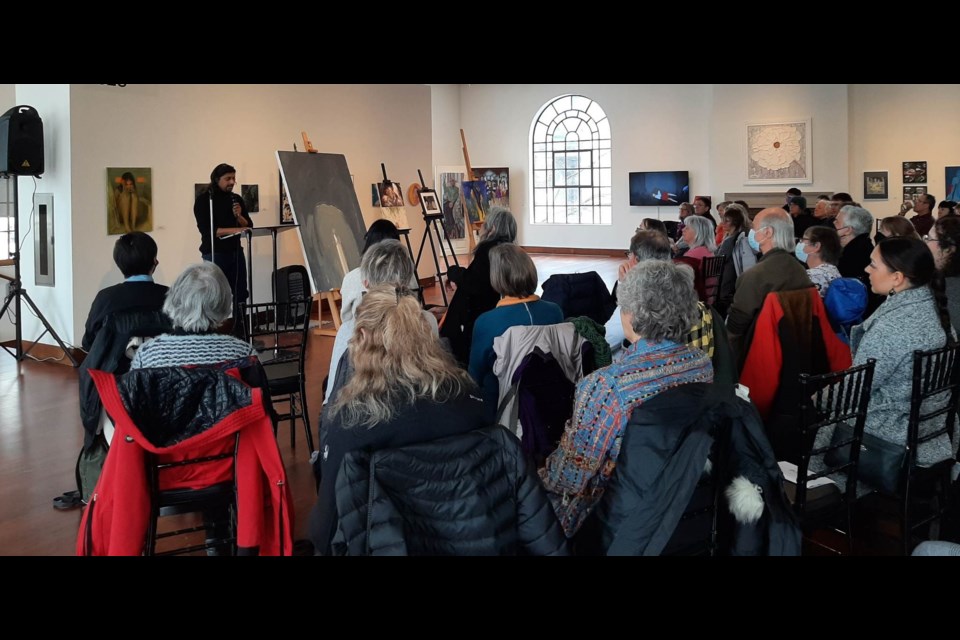“Having humility does not mean you value yourself less. Humility is not to think less of oneself, but to think of oneself, less. We are all equal, no more no less,” said Orillia artist Xavier Fernandes during a talk focused on humility at the MacLaren Art Centre in Barrie on Saturday night.
The forum was the third session of A Visual Reconciliation, a series of events sponsored by the Orillia District Arts Council (ODAC) presenting artists of different cultures and their look at the tenets of the Seven Grandfather teachings. The project was conceived by lead artist Paul Shilling (Dazaunggee) of Rama First Nation.
There will be seven events in total, each focusing on one of the Indigenous Seven Grandfather Teachings: bravery, honesty, humility, love, respect, truth, and wisdom. Each of the four artists involved in the project create a piece in their medium reflecting their thinking on each of the teachings.
The artists involved are Julie Tian, Ted Fullerton, Fernandes, and Dazaunggee.
The first gathering, focusing on the teaching of bravery, occurred at Creative Nomad Studios in November of 2022 and the second gathering, held Jan. 18 at the Orillia campus of Georgian College, shone the spotlight on the teaching of honesty.
The audience of more than 50 people at the MacLaren Art Centre was engaged and attentive during the artist talks and the lengthy question-and-answer period that followed. Each artist mused on the word humility as it related to them, their culture, their work, and the work of truth and reconciliation.
Dazaunggee, an Indigenous artist and elder from Rama, had powerful words to say about humility and humankind.
“The darker side of humility is anger, shame, hatred. This is where prejudice is born, a false ugly power. Stay in this place for too long and you lose all feelings, all compassion," said Dazaunggee.
"Mental, emotional, physical violence takes the place of the Seven Grandfather teachings. What happened to our people in the residential schools had nothing to do with these teachings,” he said.
He continued, to rousing applause: “The illusion of feeling worthless, the illusion of feeling I am more deserving than you. Humility can be a frightening word, a false voyeur.
"In some strange way, it is easier to become an actor than to search to uncover your true self. Look how we treat our women, our people of colour, our LGBTQA people," said Dazaunggee. "Humility and the grandfather teachings are inside of all of us. We all have to be who we are. We are all beautiful, none of us are better than each other. We have to heal.”
Humility meaning equality was the theme of the day. Much discussion during the question and answer period ensued around breaking down the pyramid of power, competition, and us against them, and replacing it with a circle of people, animals, birds, the environment — all equal, all important, and all working together, for the benefit of all.
Fullerton, a white Canadian male artist from Innisfil, was absent but had a fellow artist speak for him. His work showed a candle, light reflecting from it, and a shadowy figure in the background illuminated by that light. A tiny bronze of a male figure was perched on the top of the large canvas.
Fullerton’s words mused on the word humility as being confident in yourself, but being able to shine, and shine a light on others as well, “to permeate the darkness,” he said. The tiny figure at the top, he said, “has risen above the bluster of conceit, hubris and false pride.”
Tian, a young, Chinese-Canadian queer artist who makes her home in Toronto, talked about the word humility and the Chinese culture she grew up in.
“I learned that the kind of humility as defined in my Chinese culture is not really true humility as defined by the grandfather teachings,” Tian explained. “We were taught to be modest, to not bring attention to ourselves, keep our head down…but humility in this way is lowering ourselves, and the grandfather teachings teach us that humility is about being equal, and that everyone deserves respect."
Tian’s work depicted a young Chinese girl, hiding her face and laughing amongst willow boughs in the lower half of the painting, whilst the upper half depicted fireworks, something that the Chinese invented and that are very important to Chinese people today, Tian said. She mused on the dichotomy of Chinese modesty and humility versus the loud and light-filled display of fireworks.
Audience member Mary Louise Meiers said, “Each individual and each culture really is an awe-filled part of creation, no greater than a blade of grass, or the moon, and that entire system of equality and the circle is truly awe-filled.
"The circle can help us be humble and have humility. Can we come back to the awe-filled, instead of the awful?” she asked.
Fernandes, a Canadian artist who was born in Pakistan and has lived most of his life in Orillia, summed it up for everyone: “I do not know everything. So, I cannot speak as if I do. For me to have humility is to listen, observe, and be open to what Indigenous people are saying, and then react. This project is a reaction, me doing something.”
He finished, “You are also a part of that process. Being here is your chance to listen and observe and do something, share it with someone. The question is, what will you do with your knowledge after you leave here?”
The fourth part of A Visual Reconciliation, on love, will be held on April 22, from 1 to 4 p.m., at the Aurora Cultural Centre.



